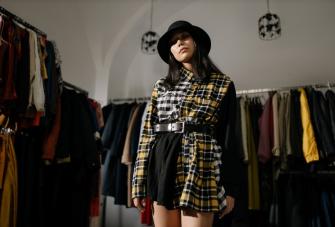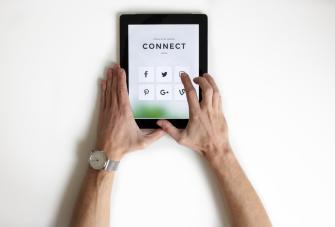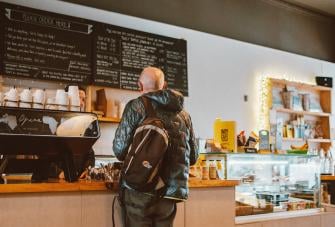The A-Z of Retail Terminology: 60 Trending Retail Terms
If you’re in the business of retail, then you need to be up with lingo. Knowing and understanding the terms used in the retail industry is your sure-fire way to stay relevant and up to date, giving you the best chance to operate your business as smoothly and successfully as possible.
So if you need help to stay up to date with the trends and technologies making the biggest impact in the retail sector, we’ve got you covered. Here, we define 60 trending terms in the retail space.
The must-read list of retail terminology
Anchor Store
This one can sometimes be referred to as “anchor tenant”, “key tenant” or “draw tenant”. In short, an anchor store is one of the largest - most often the largest - store in a shopping centre or mall. Most commonly, they are large, well-known department stores, supermarkets, or retail chain stores. They help drive foot traffic to the centre and can make a great neighbour for smaller retail stores.
Augmented Reality (AR)
This relatively new and expanding concept is all about supplementing the physical environment with a virtual one. AR brings computer-generated, 3D rendered objects into the real world.
In retail, AR can be used in several ways including fitting room simulations, shoppable catalogs, or apps that let you see in-store deals.
ATS (average transaction size)
This is a common acronym and relates to the amount spent per customer in a single transaction. It can be calculated by dividing the total value of sales in a specific time frame by the number of transactions. This figure is useful in determining whether sales size is growing.
Bar code
A barcode is a unique, machine-readable code made up of alternating dark and light lines that correspond to a number. Barcodes are used for faster checkout and can help you track inventory in and out.
Backorder
Used when a certain quantity of a product could not be fulfilled on an order, so it is put on backorder for when it is back in stock.
Big Data
This term refers to a massive amount of data that is so big you would need a sophisticated computer program or data scientist to make sense of any of it. No matter where the data comes from, big data means you're looking to analyse behaviours, demographics, social info, and much more.
Brick and click
This term is for those brick-and-mortar retailers that integrate with an ecommerce platform. With the two integrated, the physical store and online store are able to offer a seamless service like click and collect and in-store returns for online purchases.
Card Terminal
Also called a card reader, this machine connects to the point of sale to process card payments. Modern terminals accept contactless payments and chip-and-pin technology.
Carrying cost
Also often referred to as holding cost, carrying cost is associated with the cost of inventory and storage.
Cashwrap
This term refers to the main checkout area in a retail store. This is the place shoppers head to when they are finished shopping and ready to pay. Retailers will set up their POS Systems and ring up sales here. Cashwraps can also include merchandising shelves to capture impulse purchases.
Chargeback
Chargebacks happen when a customer disputes the charge from a business and asks their provider to reverse it. They are intended to protect the customer from unauthorised transactions but can mean the opposite for businesses.
Click and Collect
Click and collect is a service offered by retailers which enables shoppers to purchase goods online and pick them up at the physical store. Consumers love the ease of this feature because it both avoids costs associated with shipping and eliminates wait time.
Cloud POS
A cloud point of sale system is a POS system that securely stores all of your business's data on remote servers rather than on local computers and servers. It uses an internet connection to transfer the data and allows business owners full visibility of their data from anywhere in the world. Read more here about the benefits of cloud pos.
Cross Merchandising
This means the act of displaying products from alternate categories together to create add-on sales. It can be as simple as displaying burger buns next to burger patties. The pairing is a strategic move to promote the purchase of both items needed to make burgers for dinner.
Contactless Payments
Contactless payments refer to payments that are powered by near-field communication (NFC). This can include NFC-enabled bank and credit cards, and smartphones and devices. Customers can complete the transaction without ever touching a payment terminal.
Cost of goods sold
This is an accounting term that is used to describe the total cost of products sold in a time period. Sometimes referred to as COGS, this figure can appear on the profit and loss statement of a business and helps calculate the turnover.
Dead Stock
Dead stock defines merchandise or inventory that has never been sold or has been sitting in stock for a lengthy period of time. Sometimes this can be due to an item being more seasonal, or other times it can mean the item is just not in demand.
Drop-Shipping
This refers to an arrangement that happens between a retailer and a manufacturer. The retailer sends customer orders directly to the manufacturer or supplier to process and ship the product directly to the consumer. Retailers don’t need to keep the product in stock.
EFTPOS Machine
EFTPOS which is short for electronic funds transfer at point of sale is the machine used to process card payments. Other names include card terminal or reader.
Endless aisle
This is a feature of a brick and mortar store that enables the customer to browse the entire catalog of products. So rather than stocking every single item in-store, an endless aisle allows the shopper to browse all the products on an iPad or touch screen.
EPOS
Flash Sales
This relates to sales that are only available for a limited time. Generally, by offering huge discounts you can entice customers to buy during the time frame, forcing them to act quicker than usual.
Forecast
A forecast is usually an estimation of potential future demand for products and services. Using historical data allows retailers to calculate an estimate for the future.
FIFO (first in first out)
First in First out is a well-known inventory strategy that utilises the policy that the first stock in is the first stock out.
Green Retailing
This term relates to the environmentally (eco) friendly practices that retailers can adapt to. These practices can include switching out to recyclable packaging or only offering reusable shopping bags. But it doesn’t stop there, it extends to green energy like solar panels, and replacing store lighting with energy-saving options.
Gross Margin
Gross margin means the difference between how much an item costs and how much it sells for. It can be used to calculate how much sales revenue a business generates after all direct costs and expenses are subtracted.
High-Speed Retail
This is the known practice of speeding up the customer’s shopping experience. For example, drive-throughs, and mobile food trucks fit this category.
Impulse purchase
Impulse purchases or impulse buys happen when a customer purchases a product unplanned. Retailers set up impulse purchase stands throughout the store to encourage this shopping behaviour.
Internet of Things (IoT)
This is the concept of getting objects to “talk” to each other, like cars and other household appliances. With more products becoming “smart”, and able to communicate with each other, via the web this is a growing trend.
Inventory Management
This is the system that retailers use to track their inventory on hand. Inventory management systems keep track of stock on hand numbers, sold quantities, and order amounts. It helps to keep costs associated with ordering, handling and shipping are all kept in check.
Keystone Pricing
This method pertains to selling products for double their cost price. Because the maths are simple, it’s an easy way for businesses to cover all costs and make a profit.
Lay-by/Layaway
Sometimes called payments in instalments, this service allows customers to put a product on hold with a retailer until it’s completely paid off. The customer will pay in instalments over a time period and will be able to pick the product up once it has been entirely paid for.
Leveraged buy-out
Leveraged buy-out, or LBO, is the purchase of a business using borrowed money. The purchaser will choose to use the company’s assets as the bank's collateral so they can get the loan approved and use the cash flow to pay it back.
Loss Leader
Known as a marketing tool, a loss leader is an item that is sold below its cost price to attract customers to the store. This tactic is used in the hopes that customers will purchase more once they are in the store.
Markdown
Unlike sales or discounts, a product markdown is the permanent price reduction of a product. Usually, this can happen on products that are slow-moving or you just need to make room in your store for new inventory.
Mass customisation
This relates to a product that can be produced at a low cost but in high volume while still providing the consumer with a customised offer.
Merchandising
This is the act of displaying products in your shop in a visually appealing way to encourage customers to purchase it. It can include props, pricing signs, packaging, and more. Read more on visual merchandising here.
Mobile Payments
This refers to the services and tech that enable customers to pay using their mobile devices instead of traditional forms of payment. Currently, the most common ones include NFC-based solutions such as Apple Pay or Google Pay or apps like PayPal.
Mystery shopping
This is something used by research companies, watchdog groups and even competitive retailers to evaluate both the product range and services of a shop. A mystery shopper will act as a regular shopper and report back on their in-store shopping experience.
Niche retailing
This relates to selling only to a very specific market. Niche retailers will specialise in specific products or services.
Net profit
This is the actual profit after all expenses have been paid. It is simply calculated by subtracting operating expenses from gross profit.
Net Sales
This pertains to the amount of revenue a business generates during a particular period of time, after subtracting returns, markdowns, and any discounts applied.
Omnichannel marketing
This kind of marketing aims to give customers a seamless experience across all of the available marketing channels. Omnichannel marketing does differ from multichannel marketing in the way it is the practice of connecting communication between all of the channels. The overall goal is to keep customers moving within the brand's own marketing ecosystem.
Order lead time
This is the number of days it takes for a product to reach the store after an order has been sent. An important factor to consider when ordering popular products that sell out often.
Planogram
A planogram is a visual plan that shows the layout of merchandise on shelves with the aim of driving sales. It can also be used as a guide when store mapping and help retailers utilise their space efficiently.
Pop up shop
This is a short-term store that uses a physical location for a limited period of time. Pop-ups can literally be set up anywhere.
Prestige Pricing
This relates to a strategy adopted by high-end retailers to demonstrate a product's exclusivity or luxury by pricing it at a high level. It is used to attract status-conscious customers and those that want premium level products.
Point of sale (POS) system
Quite simply, a POS system generally describes the function of a cash register or till. They let retailers ring up sales and act as a way of recording all transactions. But advancements in technology over the years have seen POS systems grow to be much more than just a way to process a sale. These days, retail POS systems, like Epos Now, can offer businesses inventory management solutions, in-depth reporting functions, and the ability to integrate with customer loyalty and ecommerce platforms.
Purchase order
A purchase order is used to document communication between suppliers and retailers. It will typically include quantities, agreed pricing, and expected delivery dates.
Quantity on hand
This relates to the physical number of a product that the retailer has in stock.
Quantity on order
This number relates to the stock that is currently on an open purchase order.
Relationship Retailing
This is a strategy that retailers use to build loyalty and establish lasting relationships. This can include strategies such as loyalty programs, great return policies, or VIP customer service.
RFID
This is an acronym for Radio Frequency Identification. An RFID chip will be embedded in a product’s label or packaging and used primarily for tracking purposes.
Self-Serve
In a retail store, this is the process of allowing customers to select and pay for the item themselves without the assistance of a staff member. Things like self-serve checkouts and kiosks fall into this category.
Shrinkage
Shrinkage relates to the difference found between physical stock counts and the amount of stock that is documented in data. The most common causes of shrinkage happen due to theft, shoplifting, admin errors, and supplier issues.
Stock Keeping Unit (SKU)
Usually a number, an SKU is used by retailers to track stock internally. They are most commonly used in inventory management to distinguish one item from another including attributes such as brand, size, and colour.
Social Commerce
Often referred to as S-Commerce, social commerce is the practice of incorporating social media with ecommerce and retail models. Social networks are used as a means to assist in the process of driving sales.
Showrooming
This is becoming a common practice where consumers are examining products in-store only to then turn around and buy them online generally at a lower price. Price check apps are fueling this practice because they easily allow shoppers to compare prices straight from their phones.
Tribetailing
This is the practice of tailoring everything your retail store does for a specific group of people or tribe. The goal is to not appeal to the masses, but a more tailored or niche group of customers.
Units per transaction (UPT)
This is the average measurement of the number of products sold during a transaction. It’s a metric that can be used to track growth.
Webrooming
This is the opposite of showrooming and is the practice of looking at products online before actually purchasing them from brick and mortar stores.
Warehouse Management System
This is generally a specifically designed software used to manage the movement and storage of items in a warehouse.




